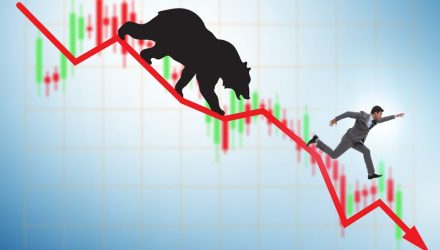As major Wall Street Banks warn of further pain ahead after the markets suffered their worst one-day loss in two years, investors can turn to bearish or inverse exchange traded fund strategies to hedge any further downside risks.
Barclays strategists warned that margins for U.S. companies and their forward earnings were still under pressure from a combination of economic weakness in China following the COVID lockdowns, the war in Ukraine, and the U.S. Federal Reserve’s hawkish stance, Reuters reports.
“Given the numerous negative near-term catalysts for the SPX we believe that the risks remain firmly stacked to the downside,” Barclays strategists said in a note, referring to the S&P 500.
The underwhelming earnings season results among the high-flying FAANG group, including Facebook’s Meta Platforms, Apple, Amazon.com, Netflix, and Alphabet, were a major contributing factor of weakness, according to Barclays. The results were also seen as the largest negative contributor to the broader index in seven years.
Barclays also noted that fiscal stimulus from the post-pandemic recovery efforts fueled record consumption of goods as consumers spent during lockdowns, which translated to strong corporate earnings in the past two years. However, consumer spending has shifted to services, so support for corporate earnings would not be so strong.
In addition, Goldman Sachs strategists warned of a 35% probability of the U.S. economy falling into a recession over the next two years, adding that the rotation out of some categories of shares and into others suggested that investors were pricing in even greater odds of a downturn.
ETF traders who are looking to protect their portfolios from potential pullbacks ahead may consider some exposure to bearish or inverse ETFs to hedge against further falls.
For example, the ProShares Short S&P500 (NYSEArca: SH) takes a simple inverse or -100% daily performance of the S&P 500 index. Alternatively, for the more aggressive trader, leveraged options include the ProShares UltraShort S&P500 ETF (NYSEArca: SDS), which tries to reflect -2x or -200% of the daily performance of the S&P 500, the Direxion Daily S&P 500 Bear 3x Shares (NYSEArca: SPXS), which takes -3x or -300% of the daily performance of the S&P 500, and the ProShares UltraPro Short S&P 500 ETF (NYSEArca: SPXU), which also takes -300% of the daily performance of the S&P 500.
Those who want to hedge against risk in the Dow Jones Industrial Average can use inverse ETFs to bolster their long equities positions. The ProShares Short Dow 30 ETF (NYSEArca: DOG) tries to reflect -100% of the daily performance of the Dow Jones Industrial Average. For more aggressive traders, the ProShares UltraShort Dow 30 ETF (NYSEArca: DXD) takes the -200% of the Dow Jones, and the ProShares UltraPro Short Dow 30 (NYSEArca: SDOW) reflects the -300% of the Dow.
Lastly, investors can also hedge against a dipping Nasdaq through bearish options as well. For instance, the ProShares Short QQQ ETF (NYSEArca: PSQ) takes the inverse or -100% daily performance of the Nasdaq-100 Index. For the aggressive trader, the ProShares UltraShort QQQ ETF (NYSEArca: QID) tracks the double inverse or -200% performance of the Nasdaq-100, and the ProShares UltraPro Short QQQ ETF (NasdaqGM: SQQQ) reflects the triple inverse or -300% of the Nasdaq-100.
For more news, information, and strategy, visit VettaFi.
